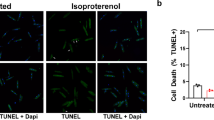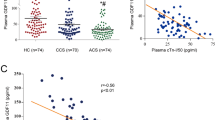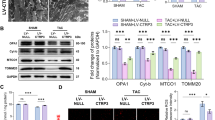Abstract
Transforming growth factor β1 (TGFβ1) has been purported to protect tissues from ischemia–reperfusion (I-R) injury. This study was designed to examine if overexpression of TGFβ1 using adeno-associated virus type 2 (AAV) protects cardiomyocytes from reoxygenation injury. TGFβ1 was overexpressed in cultured HL-1 mouse cardiomyocytes by transfection with AAV/TGFβ1Latent or with AAV/TGFβ1ACT (active TGFβ1). TGFβ1 upregulation reduced cardiomyocyte apoptosis and necrosis induced by 24 h of hypoxia followed by 3 h of reoxygenation concomitant with reduction in reactive oxygen species release, activation of nicotinamide adenine dinucleotide phosphate (NADPH) oxidase and NF-κB expression. Transfection with AAV/TGFβ1ACT was superior to that with AAV/TGFβ1Latent. To determine if AAV/TGFβ1ACT upregulation in vivo would induce cardioprotection from I-R injury, rat hearts were injected with AAV/TGFβ1ACT or phosphate-buffered saline (PBS). Six weeks later, TGFβ1ACT was upregulated throughout the myocardium. Following I-R, AAV/TGFβ1ACT-overexpressing rats had much smaller infarct size (P<0.01 vs PBS group), which was also related to reduced activation of NADPH oxidase and NF-κB, and lower levels of malondialdehyde in I-R tissues. These data demonstrate that overexpression of TGFβ1 by AAV can protect cardiac tissues from reperfusion injury, possibly via antioxidant mechanism. These findings suggest potential of TGFβ1ACT gene therapy for cardioprotection from I-R injury.
This is a preview of subscription content, access via your institution
Access options
Subscribe to this journal
Receive 12 print issues and online access
$259.00 per year
only $21.58 per issue
Buy this article
- Purchase on Springer Link
- Instant access to full article PDF
Prices may be subject to local taxes which are calculated during checkout





Similar content being viewed by others
References
Lefer A, Tsao P, Aoki N, Palladino Jr MA . Mediation of cardioprotection by transforming growth factor-β. Science 1990; 249: 61–64.
Lefer A, Ma X, Weyrich A, Scalia R . Mechanism of the cardioprotective effect of transforming growth factor beta 1 in feline myocardial ischemia and reperfusion. Proc Natl Acad Sci USA 1993; 90: 1018–1022.
Yang BC, Zander D, Mehta JL . Hypoxia-reoxygenation-induced apoptosis in cultured adult rat myocytes and the protective effect of platelets and transforming growth factor-beta 1. J Pharmacol Exp Ther 1999; 291: 733–738.
Chen H, Li D, Saldeen T, Mehta JL . TGF-beta 1 modulates NOS expression and phosphorylation of Akt/PKB in rat myocytes exposed to hypoxia-reoxygenation. Am J Physiol 2001; 281: H1035–H1039.
Mehta J, Li D, Chen H . Protection of myocytes from hypoxia-reoxygenation injury by nitric oxide is mediated by modulation of TGF-β1 . Circulation 2002; 105: 2206–2211.
Hermonat PL, Li D, Yang B, Mehta JL . Mechanism of action and delivery possibilities for TGFβ1 in the treatment of myocardial ischemia. Cardiovasc Res 2007; 74: 235–243.
Blobe G, Schiemann W, Lodish H . Role of transforming growth factor beta in human disease. N Eng J Med 2000; 342: 1350–1358.
Pang L, Ye W, Che X, Roessler BJ, Betz AL, Yang GY . Reduction of inflammatory response in the mouse brain with adenoviral-mediated transforming growth factor-ss1 expression. Stroke 2001; 32: 544–552.
Mehta J, Yang B, Strates B, Mehta P . Role of TGF-β1 in platelet-mediated cardioprotection during ischemia–reperfusion in isolated rat hearts. Growth Factors 1999; 16: 179–190.
Hoffmeyer MR, Jones SP, Ross CR, Sharp B, Grisham MB, Laroux FS et al. Myocardial ischemia/reperfusion injury in NADPH oxidase-deficient mice. Circ Res 2000; 87: 812–817.
Xiao X, Li J, Samulski RJ . Efficient long-term gene transfer into muscle tissue of immunocompetent mice by adeno-associated virus vector. J Virol 1996; 70: 8098–8108.
Jiang H, Pierce GF, Ozelo MC, de Paula EV, Vargas JA, Smith P et al. Evidence of multiyear factor IX expression by AAV-mediated gene transfer to skeletal muscle in an individual with severe hemophilia B. Mol Ther 2006; 14: 452–455.
Soeki T, Tamura Y, Shinohara H, Tanaka H, Bando K, Fukuda N . Role of circulating vascular endothelial growth factor and hepatocyte growth factor in patients with coronary artery disease. Heart Vessels 2000; 15: 105–111.
Nakamura T, Mizuno S, Matsumoto K, Sawa Y, Matsuda H, Nakamura T . Myocardial protection from ischemia/reperfusion injury by endogenous and exogenous HGF. J Clin Invest 2000; 106: 1511–1519.
Marleau S, Mulumba M, Lamontagne D, Ong H . Cardiac and peripheral actions of growth hormone and its releasing peptides: relevance for the treatment of cardiomyopathies. Cardiovasc Res 2006; 69: 26–35.
Rohr U, Kronenwett R, Grimm D, Kleinschmidt J, Haas R, Haas R . Primary human cells differ in their susceptibility to rAAV-2-mediated gene transfer and duration of reporter gene expression. J Virol Methods 2002; 105: 265–275.
Dressman D, Araishi K, Imamura M, Sasaoka T, Liu LA, Engvall E et al. Delivery of alpha-and beta-sarcoglycan by recombinant adeno-associated virus: efficient rescue of muscle, but differential toxicity. Hum Gene Ther 2002; 13: 1631–1646.
Duan D, Sharma P, Yang J, Yue Y, Dudus L, Zhang Y et al. Circular intermediates of recombinant adeno-associated virus have defined structural characteristics responsible for long-term episomal persistence in muscle tissue. J Virol 1998; 72: 8568–8577.
Shibata R, Sato K, Pimentel DR, Takemura Y, Kihara S, Ohashi K et al. Adiponectin protects against myocardial ischemia–reperfusion injury through AMPK- and COX-2-dependent mechanisms. Nat Med 2005; 11: 1096–1103.
Chen H, Mohuczy D, Li D, Kimura B, Phillips MI, Mehta P et al. Protection against ischemia/reperfusion injury and myocardial dysfunction by antisense-oligodeoxynucleotide directed at angiotensin-converting enzyme mRNA. Gene Therapy 2001; 8: 804–810.
Bujak M, Frangogiannis NG . The role of TGF-beta signaling in myocardial infarction and cardiac remodeling. Cardiovasc Res 2007; 74: 184–195.
Mehta JL, Attramadal H . The TGF beta superfamily in cardiovascular biology. Cardiovasc Res 2007; 74: 181–183.
Ruiz-Ortega M, Rodriguez-Vita J, Sanchez-Lopez E, Carvajal G, Egido J . TGF-β signaling in vascular fibrosis. Cardiovasc Res 2007; 74: 196–206.
Fava RA, Olsen NJ, Postlethwaite AE, Broadley KN, Davidson JM, Nanney LB et al. Transforming growth factor beta 1 (TGF-β1) induced neutrophil recruitment to synovial tissues: implications for TGF-β-driven synovial inflammation and hyperplasia. J Exp Med 1991; 173: 1121–1132.
Wahl SM, Hunt DA, Wakefield LM, McCartney-Francis N, Wahl LM, Roberts AB et al. Transforming growth factor type beta induces monocyte chemotaxis and growth factor production. Proc Natl Acad Sci USA 1987; 84: 5788–5792.
Smith WB, Noack L, Khew-Goodall Y, Isenmann S, Vadas MA, Gamble JR . Transforming growth factor-beta 1 inhibits the production of IL-8 and the transmigration of neutrophils through activated endothelium. J Immunol 1996; 157: 360–368.
Celada A, Maki R . Transforming growth factor-beta enhances the M-CSF and GM-CSF-stimulated proliferation of macrophages. J Immunol 1992; 148: 1102–1105.
Tang Y, Schmitt-Ott K, Qian K, Kagiyama S, Phillips MI . Vigilant vectors: adeno-associated virus with a biosensor to switch on amplified therapeutic genes in specific tissues in life-threatening diseases. Methods 2002; 28: 259–266.
Li D, Liu Y, Chen J, Velchala N, Amani F, Nemarkommula A et al. Suppression of atherogenesis by delivery of TGFbeta1ACT using adeno-associated virus type 2 in LDLR knockout mice. Biochem Biophys Res Commun 2006; 344: 701–707.
Qian SW, Kondaiah P, Roberts AB, Sporn MB . cDNA cloning by PCR of rat transforming growth factor β-1. Nucleic Acids Res 1990; 18: 3059.
Liu Y, Santin AD, Mane M, Chiriva-Internati M, Parham GP, Ravaggi A et al. Transduction and utility of the granulocyte-macrophage colony-stimulating factor gene into monocytes and dendritic cells by adeno-associated virus. J Interferon Cytokine Res 2000; 20: 21–30.
Claycomb WC, Lanson NA, Stallworth BS, Egeland DB, Delcarpio JB, Bahinski A et al. HL-1 cells: a cardiac muscle cell line that contracts and retains phenotypic characteristics of the adult cardiomyocyte. Proc Natl Acad Sci USA 1998; 95: 2979–2984.
Chaudary N, Naydenova Z, Shuralyova I, Coe IR . Hypoxia regulates the adenosine transporter, mENT1, in the murine cardiomyocyte cell line, HL-1. Cardiovasc Res 2004; 61: 780–788.
Chen J, Mehta JL, Haider N, Zhang X, Narula J, Li D . Role of caspases in Ox-LDL-induced apoptotic cascade in human coronary artery endothelial cells. Circ Res 2004; 94: 370–376.
Jamnicki-Abegg M, Weihrauch D, Pagel PS, Kersten JR, Bosnjak ZJ, Warltier DC et al. Isoflurane inhibits cardiac myocyte apoptosis during oxidative and inflammatory stress by activating Akt and enhancing Bcl-2 expression. Anesthesiology 2005; 103: 1006–1014.
Ericson K, Saldeen TG, Lindquist O, Pahlson C, Mehta JL . Relationship of Chlamydia pneumoniae infection to severity of human coronary atherosclerosis. Circulation 2000; 101: 2568–2571.
Fu XW, Wang D, Nurse CA, Dinauer MC, Cutz E . NADPH oxidase is an O2 sensor in airway chemoreceptors: Evidence from K+ current modulation in wild-type and oxidase-deficient mice. Proc Natl Acad Sci USA 2000; 97: 4374–4379.
Ranganathan G, Unal R, Pokrovskaya I, Yao-Borengasser A, Phanavanh B, Lecka-Czernik B et al. The lipogenic enzymes DGAT1, FAS, and LPL in adipose tissue: effects of obesity, insulin resistance, and TZD treatment. J Lipid Res 2006; 47: 2444–2450.
Acknowledgements
This study was supported by a grant from the Department of Veterans Affairs and the National American Heart Association.
Author information
Authors and Affiliations
Corresponding author
Rights and permissions
About this article
Cite this article
Dandapat, A., Hu, C., Li, D. et al. Overexpression of TGFβ1 by adeno-associated virus type-2 vector protects myocardium from ischemia–reperfusion injury. Gene Ther 15, 415–423 (2008). https://doi.org/10.1038/sj.gt.3303071
Received:
Revised:
Accepted:
Published:
Issue Date:
DOI: https://doi.org/10.1038/sj.gt.3303071
Keywords
This article is cited by
-
Grpel2 maintains cardiomyocyte survival in diabetic cardiomyopathy through DLST-mediated mitochondrial dysfunction: a proof-of-concept study
Journal of Translational Medicine (2023)
-
Promise of adeno-associated virus as a gene therapy vector for cardiovascular diseases
Heart Failure Reviews (2017)
-
Immunity, Inflammation, and Oxidative Stress in Heart Failure: Emerging Molecular Targets
Cardiovascular Drugs and Therapy (2017)
-
Gene- and cell-based bio-artificial pacemaker: what basic and translational lessons have we learned?
Gene Therapy (2012)
-
AAV Vectors for Cardiac Gene Transfer: Experimental Tools and Clinical Opportunities
Molecular Therapy (2011)



